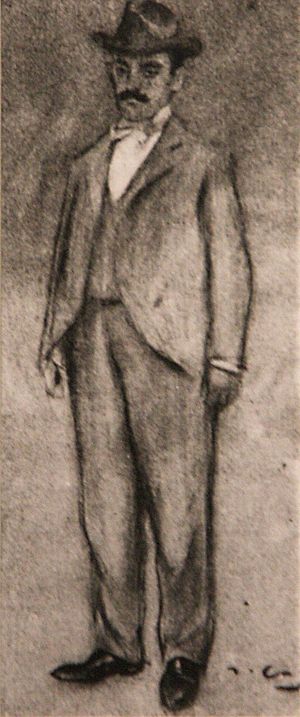Pere Coromines i Montanya facts for kids
Quick facts for kids
Pere Coromines i Montanya
|
|
|---|---|
 |
|
| Born | 6 May 1870 |
| Died | 30 November 1939 (aged 69) |
Pere Coromines i Montanya (born in Barcelona, Spain, on May 6, 1870 – died in Buenos Aires, Argentina, on November 30, 1939) was an important Catalan writer, politician, and economist. He played a big role in the public life of Catalonia and Spain during a time of many changes.
Contents
His Early Life and Education
Pere Coromines was the son of Domingo Coromines i Frexanet and Maria Montanya i Mercader. He grew up in Barcelona.
In 1894, he finished his law degree at the University of Barcelona. During his younger years, he was interested in many different ideas. He connected with groups that supported Catalan culture, republican ideas, and even some anarchist groups.
He worked for a magazine called L’Avenç starting in 1895. He also helped start a cultural group called Foc Nou. Through these activities, he met many people with new and exciting ideas.
A Difficult Time: The Montjuïc Trial
Because of his connections with some anarchist groups, Pere Coromines came under suspicion from the Spanish authorities. In 1896, after a bombing in Barcelona, he was arrested.
He was part of a big trial known as the Montjuïc trial. He faced very serious accusations. In the end, he was sentenced to eight years in prison.
However, in 1897, the Spanish government sent him to live in France. He stayed there until 1901, when a new government gave him amnesty, which meant he could return home.
Soon after returning, he continued his studies. He earned a higher degree in law and studied economics at the University of Madrid. While in Madrid, he worked hard to help others who had been wrongly accused in the Montjuïc trial. Famous people like Miguel de Unamuno supported his efforts.
Pere Coromines's Public Life
In 1903, Pere Coromines returned to Barcelona. He started working in the financial department of the City Council of Barcelona. He helped write important reports about the city's money.
In 1907, he became a founding member of the Institut d'Estudis Catalans. This is a very important institution that studies Catalan language and culture. He joined its History and Archaeology section, and later its Science section.
A Leader in Politics
In 1901, Pere Coromines became the president of the Republican Nationalist Federal Union. He also directed a newspaper called El Poble Català.
He was elected to the City Council of Barcelona in 1909. Then, in 1910 and 1914, he became a member of the Spanish Parliament. He tried to bring different political groups together, but it didn't work out. Because of this, he stepped away from active politics for a while.
From 1916, he worked as a lawyer and gave talks in Madrid. He also served as a secretary for the Bank of Catalonia.
His Later Years and Legacy
During the time of Miguel Primo de Rivera's rule (a period when Spain was run by a dictator), Pere Coromines focused on writing. He wrote for several publications, including La Humanitat and Revista de Catalunya. He also led the Ateneu Barcelonès, a famous cultural center, from 1928 to 1930.
He returned to politics when the Second Spanish Republic was formed. Because of his knowledge and experience, he was asked to help write the Estatut de Núria, an important document for Catalonia. In 1933, he was appointed as a counselor for Justice and Law.
In 1936, he was elected to parliament again for the Republican Left of Catalonia. During the Spanish Civil War, he worked as the General Museum Commissioner for the Generalitat de Catalunya, which is the government of Catalonia.
When the war ended, he moved to Buenos Aires, Argentina, with his family. He passed away there shortly after.
His Family
Pere Coromines married Celestina Vigneaux i Cibils, who was a teacher. They had several children together. Some of them became well-known, like Joan Coromines i Vigneaux, who was a famous language expert, and Ernest Corominas i Vigneaux, who was a mathematician.
His Books
Pere Coromines wrote many books and essays. Here are some of his works:
- Les presons imaginàries (1899)
- La vida austera (1908)
- Les hores d'amor serenes (1912)
- Les gràcies de l'Empordà (1919)
- Elogi de la civilització catalana (1921)
- Cartes d'un visionari (1921)
- A recés dels tamarius (1925)
- Les dites i facècies de l'estrenu filantrop en Tomàs de Bajalta, a series of three books: Silèn (1925), Pigmalió (1928), and Prometeu (1934)
- Jardins de Sant Pol (1927)
- La mort de Joan Apòstol (1928)
- Les llàgrimes de sant Llorenç (1929)
- Pina, la italiana del dancing (1933)
- Interpretació del vuit-cents català (1933)
- Del meu comerç amb Joan Maragall (1935)
- El perfecte dandi i altres contes (1940)
See also
 In Spanish: Pedro Corominas para niños
In Spanish: Pedro Corominas para niños

